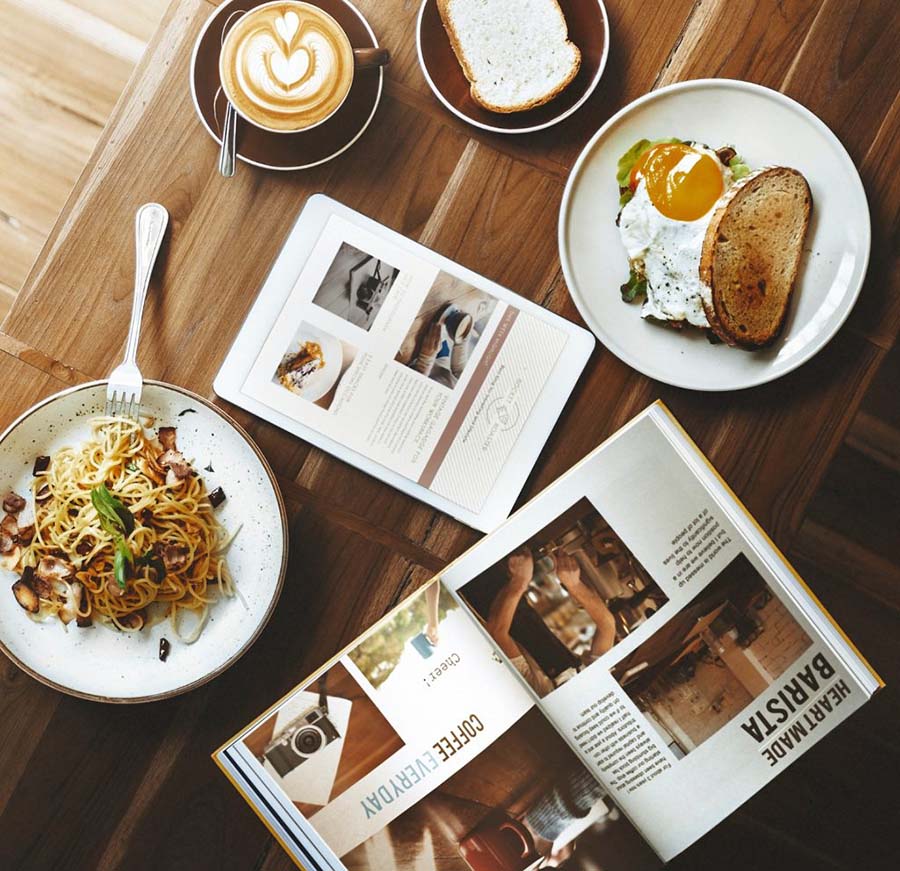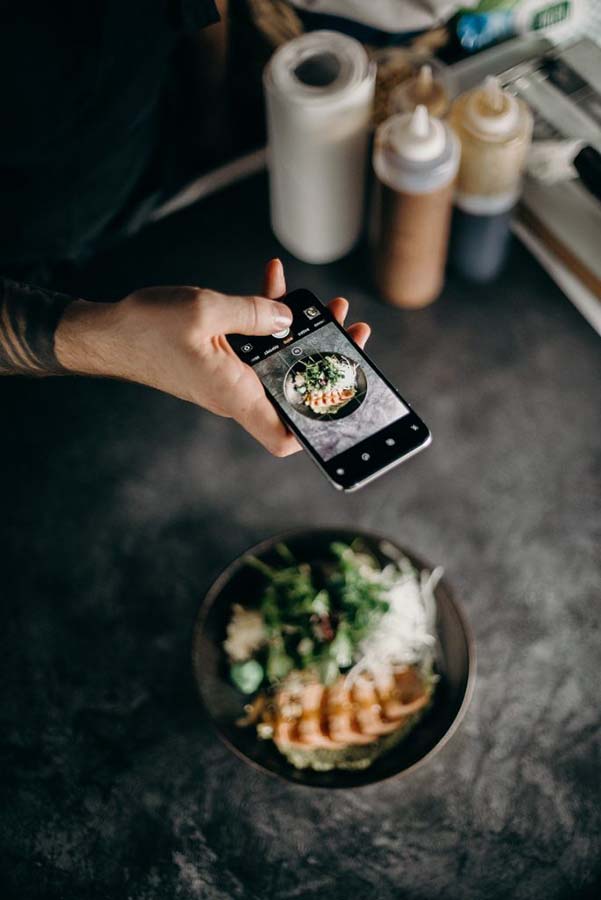From #foodporn to Frenzies: Social Media’s Culinary Craze

Introduction
Food and drink have always been an integral part of our culture, with people worldwide using food to connect, celebrate, and express themselves. However, in today’s digital age, social media has revolutionised how we interact with food and drink, transforming the culinary landscape in unprecedented ways. From the rise of food and drink influencers to the impact of user-generated content on restaurant reviews, social media has changed how we approach and experience food and drink in previously unimaginable ways.
In this blog, we will explore the influence of social media on food and drink culture, examining how social media has impacted the food and drink industry, consumer behaviour, and cultural norms. In addition, we will discuss the rise of food and drink influencers, the role of visuals in promoting food and drink trends, the impact of social media on food and drink businesses, and the effect of social media on food and drink culture more broadly.
“Over 80% of consumers say they’ve discovered a new food or drink product on social media.”
— GlobalWebIndex
First, we will discuss the rise of food and drink influencers on social media, exploring the impact of influencer marketing on food and drink trends and the pros and cons of influencer culture. Next, we will explore the role of visuals in food and drink culture, analysing the psychological effects of food and drink visuals on social media users and how visuals can influence people’s choices regarding food and beverages.
We will then move on to the impact of social media on food and drink businesses, examining how social media has changed the way food and beverages businesses market and sell their products, the impact of user-generated content on restaurant reviews, and the potential downsides of social media for food and drink businesses.
Finally, we will discuss the effect of social media on food and drink culture more broadly, examining the benefits and drawbacks of the changes brought about by social media and providing insight into the future of social media’s influence on food and drink culture.
The Rise of Food and Drink Influencers
Over the past few years, the increasing popularity of social media has brought forth a new type of notable figure known as food and drink influencers. These active social media users have amassed a significant following by posting photos and videos of food and drink and providing recommendations, recipes, and other food-related content.
The impact of food and drink influencers on the industry has been significant. By promoting certain foods and drinks, influencers can create trends, shape consumer preferences, and influence people’s choices regarding food and drink. Studies have shown that more than 80% of consumers have tried a new food or drink product after seeing it on social media.
One of the most notable examples of the power of food and drink influencers is the rise of avocado toast. While avocado toast had been a popular breakfast item for years, it was when influencers began sharing photos of their versions on social media that it became a significant trend. Today, avocado toast is a staple on breakfast menus worldwide, and its popularity shows no signs of waning.
Despite their power to influence consumer behaviour, there are both pros and cons to influencer marketing in the food and drink industry. On the one hand, influencer marketing can be an effective way for businesses to reach a large, engaged audience, especially given the decline of traditional advertising channels like print and TV. On the other hand, by partnering with food and drink influencers, businesses can tap into their followers, increase brand awareness, and drive sales.
“Food and drink is the third most popular category on Instagram, with over 500 million daily active users engaging with food content.”
— Instagram Business
However, there are also concerns about the authenticity of influencer marketing. With so much money on the line, it’s common for influencers to accept sponsorships from brands they don’t necessarily believe in, leading to a lack of transparency and trust. Additionally, there is a risk that influencer marketing can perpetuate harmful food and drink trends, such as fad diets or unhealthy eating habits, in pursuit of likes and engagement.
Despite these concerns, there is no denying that food and drink influencers have become a significant force in the industry, and their impact will continue to be felt. As social media continues to evolve, it will be interesting to see how food and drink influencers adapt to new platforms and changing consumer preferences and how businesses and consumers respond to their influence.
The Role of Visuals in Food and Drink Culture
It’s no secret that visuals are vital to social media, especially regarding food and drink. From perfectly plated dishes to mouth-watering drinks, visuals cannot be underestimated in promoting food and drink trends.

Studies have shown that photos and videos are the most engaging content on social media, with food and drink content being some of the most popular. This is likely because food and drink visuals tap into our basic human instincts and desires – the need for sustenance, pleasure, and social connection.
The psychological effects of food and drink visuals on social media users are significant. Research has shown that seeing images of food and drink can trigger hunger, cravings, and a desire to eat, even if the person isn’t hungry. Additionally, food and drink visuals have been shown to increase the perceived value of a product, leading people to be more willing to pay a higher price for something that looks appealing.
Given the power of visuals in promoting food and drink trends, it’s unsurprising that businesses and influencers alike have invested heavily in creating high-quality photos and videos to showcase their products. But it’s not just about making things look pretty – visuals can also influence people’s choices regarding food and drink.
For example, studies have shown that people are likelier to choose a food item with a photo associated with it, even if they don’t know anything about the product or its ingredients. Additionally, people are more likely to choose a food or drink visually appealing item, even if it doesn’t taste as good as something that looks less attractive.
“68% of millennials take photos of their food and share them on social media.”
— Maru/Matchbox
This has led to some criticism of the role of visuals in food and drink culture, with some arguing that the emphasis on appearance over taste or nutritional value is harmful. However, it’s worth noting that visuals can also promote healthy eating habits and positive body image, and many food and drink influencers are using their platforms to do just that.
Overall, the role of visuals in food and drink culture is undeniable. From promoting trends to influencing consumer behaviour, photos and videos significantly impact how we think about and interact with food and drink. As social media continues to evolve, it will be interesting to see how visuals shape our relationship with food and drink and how businesses and influencers use them to their advantage.
The Impact of Social Media on Food and Drink Businesses
Social media has revolutionised how businesses market and sell their products, and the food and drink industry is no exception. Social media has transformed how food and drink businesses operate, from promoting new products to engaging with customers.
One of the most significant changes social media brings is the rise of user-generated content. For example, customers can now share their experiences with food and drink businesses through reviews, photos, and videos on social media platforms. This has created a new form of marketing that is more authentic and trustworthy than traditional advertising, as people are more likely to trust the opinions of their peers than a brand’s messaging.

Food and drink businesses have also used social media to build their communities of followers and fans, allowing them to engage with their audience in real time and build brand loyalty. This has enabled them to better understand their customers’ needs and preferences and tailor their products and services accordingly.
However, social media also presents potential downsides for food and drink businesses. Negative reviews and comments can spread quickly on social media, potentially damaging a business’s reputation. Additionally, businesses must monitor their online presence and promptly and promptly and effectively respond to customer feedback.
Another potential issue is the pressure to keep up with social media trends and produce visually appealing and shareable content. This can be time-consuming and expensive, especially for smaller businesses needing more resources to create high-quality content.
“Restaurants that have a high rating on Yelp, a popular review platform, can see an increase in sales of 5-9%.”
— Harvard Business Review
Despite these challenges, the benefits of social media for food and drink businesses are clear. Businesses can build brand awareness, boost sales, and strengthen customer loyalty by creating a solid online presence and engaging with their customers through social media.
In summary, social media has brought about a significant influence on the operations of food and drink businesses, altering various aspects ranging from marketing and sales to customer engagement. Although social media presents some obstacles, the advantages are evident, and, likely; social media will persistently affect the culture of food and drink for a considerable amount of time.
The Effect of Social Media on Food and Drink Culture
The surge of social media has substantially affected the food and drink culture, altering how individuals engage with food and drink and how they perceive it.
Below are several significant ways in which social media has impacted the culture surrounding food and drink:
Changing Attitudes Towards Food and Drink: Social media has encouraged people to be more adventurous with their food choices and to try new things. The constant stream of food and drink photos on platforms like Instagram has made people more curious about different cuisines and flavours, leading to the popularity of fusion dishes and culinary experiments.
The Rise of Foodie Culture: The prevalence of social media has triggered the emergence of a fresh breed of food lover: the foodie. Foodies exhibit a keen enthusiasm for food and drink and continuously pursue the latest gastronomic trends and ventures. This has given rise to food tourism and culinary travel, where individuals explore new and thrilling food experiences to showcase on social media.
The Emergence of “Instagrammable” Food: The visual nature of social media has profoundly impacted how food is presented and consumed. As a result, food and drink establishments are now designing their menus and plating their dishes optimally for social media to create “Instagrammable” moments that will be shared and reposted.
“49% of consumers say they’ve tried a recipe they found on social media.”
— IRI Worldwide
The Influence of Social Media on Food Trends: The impact of social media in shaping food and drink trends cannot be overstated. It wields power to create or destroy a trend, from viral recipes to popular ingredients. Furthermore, the immediacy of information dissemination on social media has accelerated the spread of food and drink trends, making them more accessible and quickly adopted by a wider audience.
Despite these benefits, there are also some drawbacks to the influence of social media on food and drink culture. For example, social media can create unrealistic expectations about food and drink, leading to feelings of inadequacy or FOMO (fear of missing out) in some people. Additionally, the constant stream of food and drink content can be overwhelming, leading to a need for more appreciation for the experience of eating and drinking.
Looking ahead, it’s clear that social media will continue to impact food and drink culture significantly. As technology advances, we can expect to see even more innovative ways for people to share and engage with food and drink content. First, however, it’s essential to be mindful of social media’s potential downsides and approach food and drink with a balanced and healthy mindset. By doing so, we can continue to enjoy social media’s benefits while appreciating the simple pleasures of a good meal or drink.
Conclusion
The impact of social media on food and drink culture is substantial, as it has transformed how we approach and consume food and drink. With the emergence of food and drink influencers, our discovery of new products and purchasing habits have shifted. Furthermore, using visual aids, such as photos and videos, on social media has enabled businesses to display their products effectively and reach a broader customer base.
However, the impact of social media on the food and drink industry is not all positive. Negative reviews and comments on social media can damage businesses, and the pressure to create visually appealing content can overwhelm businesses and consumers.
Despite these challenges, social media is here to stay and will continue to shape how we interact with food and drink. To navigate social media’s influence on food and positive drink culture, it’s essential to be mindful of the sources of information and discern the content we consume. We should also prioritise supporting local businesses and seeking out authentic food experiences rather than solely relying on social media for recommendations.
In conclusion, the rise of social media has revolutionised the food and drink industry. It has made food and drink culture more accessible and created new opportunities for businesses to market and sell their products. However, we should be mindful of the potential drawbacks and strive to engage with social media in a way that supports our values and priorities.
Be sure to check out our other related posts if you enjoyed this one:
- Zoom-Ready Fashion: Must-Have Styles for Virtual Meetings!
- Jet-Setter Must-Haves: Fashionable Travel Essentials!
- Unlock Wealth Secrets: Rich Dad Poor Dad Reveals All!
- Unleash Your Earning Potential: Mastering the Gig Economy Game!
- Unlock Your Peak Performance: Fast This Way with Dave Asprey!
- Revolutionise Your Kitchen: Master Zero-Waste Cooking Magic!
- Wild Adventures and Hilarious Mishaps: Bill Bryson’s Appalachian Trail Tale!
- Mastering AutoML: Perks, Uses & Hurdles Uncovered
- Love Unveiled: Cracking the Code of Relationships with John Gray!
- Unlocking Forever: Master the Secrets to Relationship Bliss!
Sign up for updates on this blog and our latest lifestyle posts if you enjoyed reading this one.
Share our blog content with your friends and colleagues via Facebook, Twitter, Pinterest, LinkedIn, email or WhatsApp links below and help them stay informed about the latest insights on business, marketing, finance, lifestyle, and society. Let’s build a knowledge-sharing community and empower each other to achieve our goals.
Credits
- Featured image by Freepik
- Food and drink influencers photo by CottonBro studio on Pexels.
- Food and drink visual image by rawpixel.com on Freepik
- Food and drink social media impact photo by Diva Plavalaguna on Pexels










